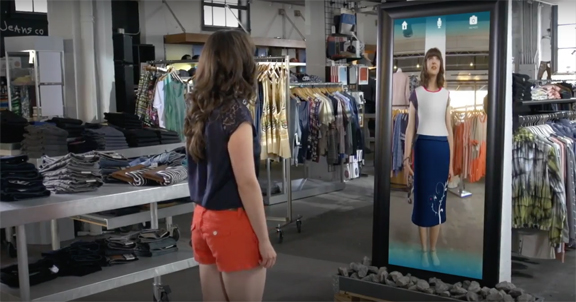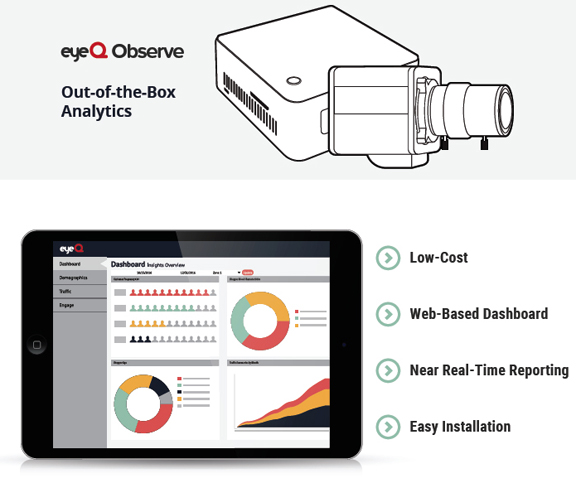IoT World 2017: Hungry for Data, Learning from AI, Learning to Read Emotions

Samsung, an exhibitor at IoT World 2017, launches connected popup retail solution (image courtesy of Samsung).
Latest News
May 25, 2017
On May 17, two events converged to cause a gridlock in Santa Clara along a stretch of the Great America Parkway. Many of the programmers, hackers, and startup founders attending the IoT World Conference at the Santa Clara Convention Center and the rock music fans going to the U2 Concert at the Levi’s Stadium were on the same route.
This year, IoT World drew 14,000 preregistered attendees, representing a 20x increase since the show launched three years ago.
“This year has been the biggest and most diverse we’ve run to date, marking a dramatic shift in the industry,” said Gavin Whitechurch, founder of IoT World. “IoT is no longer something futuristic organizations see on the horizon; it’s now a core part of their strategy.”
Watching Out
In the heart of the Buckeye State, at the Buffalo Wings & Rings restaurant in Mason, the waitstaff recently got a series of smartwatches, Samsung Gear S3 models. The watch’s classic dial face could be misleading, because it hides the smart features—apps and schedulers—you can access with the twist of the steel bezel.
Branded TaskWatch, the ones worn by the staff and managers at the Buffalo Wings & Rings are running Hipaax, a task assignment and tracking system from Samsung’s partner Hipaax. This allows the watch to issue alerts and reminders to the staff so routine tasks such as drink refills and food delivery can be completed in a timely fashion.
“The TaskWatch allows us to combine the tablet-style ordering system, the information from the point of sales system, and the activities in the kitchen, then give the servers a hand-free, wearable solution that lets them know when the orders are ready, what the guests are asking for, and when drink refreshes are due,” explained Ed Abrams, Samsung’s VP of B2B marketing. “So the front-end is a wearable with Hipaax interface, but the device is connected to the Samsung EMM (enterprise mobile management) network. A big data analytic engine is crunching the data to figure out how to best deploy the servers, how to time the deliver of the order delivery, and so on. This leverages AI and machine learning.”
The same type of watches are also on the wrists of the janitorial staff at the Cincinnati/Northern Kentucky International Airport (CVG), another Samsung customer that has deployed the TaskWatch system. “Because it has geo-location features, the system gives the facility managers a way to see if the staff is moving through the airport in a timely fashion, if they’re spending sufficient amount of time performing their tasks,” he pointed out.
 Samsung, an exhibitor at IoT World 2017, launches connected popup retail solution (image courtesy of Samsung).
Samsung, an exhibitor at IoT World 2017, launches connected popup retail solution (image courtesy of Samsung).Smile! You’re on Emotion Cam
Samsung is also developing a modular popup retail solution. “The Connected Pop-Up store powered by Samsung takes the concept of temporary retail to the next level,” the company announced. “It’s an innovative turn-key model that considers all the elements of a successful pop-up: ideation, location scouting, logistics, staffing, Point-of-Sale (POS) fulfillment, real-time customer engagement, and content creation. This is combined with next-generation technologies from Samsung, including an IoT (Internet of Things) dashboard, which captures store data and provides retail analytics and insights into store activity.”
A key piece of the popup solution is Samsung’s Artik platform, for bringing together hardware modules and cloud services. Another component comes from eyeQ, which offers technology to translate webcam-captured imagery into demographics, sentiments, and emotions. For example, a scowling face, based on generally recognizable eyebrow and lip curvature, can be recognized as a consumer’s skepticism or disaffection. The general hight and physique of the shoppers passing through a monitoring point could be interpreted as age and gender demographics.
“Samsung built the analytic dashboard that takes that data and makes it usable,” explained Abrams.
With technologies that discreetly monitor shoppers for market intelligence, some IoT devices will invariably get too close to the edge of the consumers’ privacy. Most shoppers accept, for instance, security monitoring in shopping malls us a fair practice, both to keep them safe and to prevent shoplifting. But it’s unclear how they would feel if they know their emotions, too, are being monitored.
“We are fully committed to full disclosure,” said Abrams. “We work with retailers to ensure they are letting their customers know, even before they come into the popup store, that information is being captured.”
 eyeQ, a partner of Samsung in the popup retail solution project, offers technology to interpret camera-captured images into shopper demographics and sentiments.
eyeQ, a partner of Samsung in the popup retail solution project, offers technology to interpret camera-captured images into shopper demographics and sentiments.Are You On the Edge?
Part of the trend that drives machine learning, big data analysis, and AI development is the dramatically lowered price of storage and computing. When you can access the horsepower of a supercomputer for a reasonable cost from the cloud, tasks that previously deemed too costly too pursue—teaching a computer to make decisions using images or process natural voices, for example—become affordable.
“In the early days of cloud computing, the highest performing computing core cost about 12 cents an hour. Today, that price is about three cents,” noted Steven Martin, GE Energy Connections’ chief digital officer. “And that price drop happened within the last five years.”
Martin suspects the computing paradigm may soon shift from the cloud to the edge, largely due to the ability to deliver unprecedented compute capacity in small devices. “Your iPhone has more compute power than what existed on the planet in the 1940s,” he pointed out for perspective. “Are we taking full advantage of that in our edge devices? Absolutely not.”
Simply put, edge devices are connected devices and products in our hands and in the fields. When it was too costly to embed too much compute power in those devices, processing had to be done through the cloud, on a remote server. But now that new microprocessors have become far more powerful, a lot of data analysis and number crunching may be possible on the device itself, without relying on the cloud.
In the panel discussion titled “From Cool to Crucial: Achieving Mass Market Success of Connected Industry, Enterprise and Consumer,” moderator Bob O’Donnell, founder and chief analyst of TECHnalysis Research, pointed out, “In tech, something five-year-old is legacy, but in manufacturing, legacy means 40 years. Think about adding sensors to 40-year-old machines and equipment.”
That may be one of the biggest challenges facing the established industry titans forging a path into IoT. With the emergence of 5G connection, anything from the 4G era may soon be considered legacy. Yet, many manufacturers are still servicing ships, planes , and plants dating back to the era of 56K model connections—or earlier.
Subscribe to our FREE magazine, FREE email newsletters or both!
Latest News
About the Author
Kenneth Wong is Digital Engineering’s resident blogger and senior editor. Email him at [email protected] or share your thoughts on this article at digitaleng.news/facebook.
Follow DE





